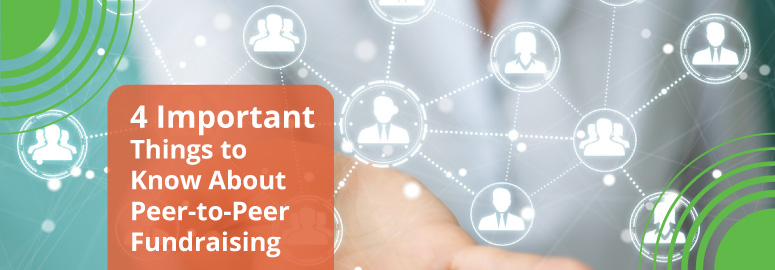
Looking for the perfect way to get your nonprofit’s supporters more involved with your fundraising while expanding your social circles? There’s a great way to do this: through peer-to-peer fundraising.
What is peer-to-peer fundraising?
Peer-to-peer fundraising is a powerful social fundraising method where nonprofits recruit volunteer fundraisers to raise money on their behalf.
But before you dive in and start building a campaign, there are some things you should know about this process. Peer-to-peer fundraising can maximize your fundraising potential only if you take the right approach, so let’s start with the basics.
First, here’s how peer-to-peer fundraising works:
- The nonprofit determines its fundraising goal and sets up a campaign page using a peer-to-peer fundraising platform.
- The nonprofit recruits individual volunteers to set up their own campaign pages.
- The nonprofit provides resources and support to the individual volunteers.
- The volunteers share their individual campaign pages with their friends and family on a variety of platforms.
- The nonprofit provides continued support and tracks the campaign’s progress.
If you want to get people to donate to your cause, peer-to-peer fundraising can expand your circle of potential donors and help you reach hundreds of donors you might not have found otherwise. With the right resources and supervision, your volunteer fundraisers can help you get even closer to (or surpass!) your fundraising goals.
In this article, we will discuss:
- Training your fundraisers
- Supporting your fundraisers
- Gamification techniques
- Events
Are you ready to take a closer look at what you need to know to make your peer-to-peer fundraiser successful? Let’s get started!

1. Train your fundraisers.
The most important thing to keep in mind when running a peer-to-peer fundraising campaign is that you need to train your volunteers. Most of them won’t have extensive experience fundraising for a cause, so they’ll need some guidance as to the best practices and resources they can incorporate.
When training your fundraisers, you should:
- Offer resources. When planning a peer-to-peer fundraising campaign, you can hold a training session, online “how-to” sessions, offer resources to read, and/or make your staff available for any questions that may arise.
- Give them tips on how to set up a campaign page. Encourage your volunteers to tell their own stories and explain why your cause means so much to them. Putting a familiar face to an otherwise unfamiliar cause will encourage others to donate even if they’re not already familiar with your organization. Just like when you’re building an online donation page, you should make it easy for supporters to donate and find information about your organization.
- Set them up with templates. Before your volunteers craft their social media messages and emails, be sure to give them a template they can use to fully explain why the cause is so important and how their contribution will make an impact. Fundraising Letters offers helpful fundraising templates to get you started.
Offering sufficient training to your volunteers should be treated just as you would treat training your staff members. Training should include valuable resources and insights as well as tips for best practices to incorporate in their own appeals. When putting on a peer-to-peer fundraiser, keep in mind that your volunteers are the central component to your success!

2. Continue supporting your fundraisers.
The support doesn’t stop after training! Even once your volunteers’ individual campaign pages have been launched, you should continue providing ongoing support to your fundraisers in case any questions or concerns arise. Doing so will help you so continue maximizing your fundraising potential and, more importantly, show them that they’re valuable to your campaign.
Throughout the campaign, try out these strategies:
-
- Schedule check-ins. Schedule regular check-ins to see how your volunteers are doing and so you can offer encouragement or feedback. Allow them to ask for clarification or bring up any related issues.
- Segment your teams. Try segmenting your volunteers into categories: those who have raised a significant amount of donations, those who have raised an average amount of donations, and those who haven’t collected anything yet. You’ll want to develop strategies for communicating with each of these groups, as their current goals will be different.
- Congratulate those who are excelling. Recognize your most successful volunteers on their progress and accomplishments. Make them feel valued and encourage them to keep going strong.
- Encourage those who are off to a slow start. Offer words of encouragement and further support to those who might be having trouble raising funds. Provide additional resources if needed and answer any queries that arise.
Offer support in as many ways as you can to keep your volunteers going strong. Encourage those who need it and congratulate those who have been successful! By keeping up communications with your supporters, you’ll be able to keep up the energy of your peer-to-peer fundraiser.
If you’re looking for the right platform to help jump-start your campaign, check out this list.

3. Use gamification techniques.
When in doubt, keep your volunteer fundraisers motivated by making fundraising a game! While motivation can be kept up by offering support and encouragement, there are many other methods you can incorporate to maximize your campaign’s fundraising potential and keep everyone engaged.
Gamification techniques are effective ways to encourage and motivate your supporters to stay involved in the fundraising process. Adding a healthy competitive edge can keep people engaged and bring in more fundraising revenue.
The best peer-to-peer fundraising platform will have the following gamification tools:
-
Leaderboards. Promote friendly competition among your volunteers by including a leaderboard on your main campaign page. Display the leaders in real time at the top. Participants will compete to get their name on the leaderboard, which will help increase your fundraising.
-
Goals and thermometers. Both your volunteers and your donors want to know how your campaign is going. After you set your fundraising goal, showcase your progress by displaying a fundraising thermometer. You can even set additional benchmarks on the thermometer to encourage further excitement each time one is met. This will inspire people to give even more and help you reach your ultimate fundraising goal.
-
Creative peer-to-peer pages. Each volunteer’s P2P page should be a place for them to show off their connection to your campaign. Encourage your volunteers to get creative with videos and other visuals that show their relationship to your cause! This way, they can better appeal to their friends and family and ask for support. For instance, making a short fundraising video will engage potential donors and give them a special, personalized introduction to your cause and campaign.
-
Badges. Badges are digital awards that you give to your peer-to-peer fundraising participants when they reach a milestone or any other type of achievement. Proud participants can display their badges on their individual peer-to-peer pages or share them to their social media profiles. Badges both reward your most passionate fundraisers and inspire other participants to work toward getting badges themselves.
-
Tangible incentives. While badges and other digital incentives are great ways to motivate your volunteers, real-life incentives are also very effective. Even small tangible rewards can motivate your participants. You could even try combining your digital incentives with tangible ones. Some good examples of tangible incentives are raffle tickets, gift cards, and event merchandise.
Volunteer fundraisers feel good when they’re recognized, and doing so will make them more likely to stay involved with the campaign. Keep encouraging them to stay engaged through gamification techniques and inspire them to put their creativity to work!

4. Lead up to an event.
One of the most important things to remember about peer-to-peer fundraising is its versatility. When you put on a peer-to-peer fundraising campaign, it can work well as a lead-up to an event. Both online fundraising (the peer-to-peer fundraising campaign) and offline fundraising (the physical event) can draw attention to your nonprofit and boost your visibility in the greater community.
For instance, let’s say you’re hosting a walk-a-thon:
- Plan and schedule your event as you normally would.
- Once the event is scheduled, invite supporters and participants to set up individual fundraising pages.
- Encourage your supporters to share their pages with friends and family. Your supporters can ask them to donate and/or encourage them to register for the walk-a-thon.
- Find other creative ways to supplement the event, such as by selling t-shirts to raise extra funds.
- Enjoy the event!
Following the event, it’s incredibly important that you thank your donors. After all, they’re the reason you’ve reached your goal! Be sure to personalize your thank-you emails and messages, send them out quickly, and highlight the impact each donation will make. As with any kind of fundraiser, thanking donors is the key to retaining them for future fundraisers and maintaining the widened social circle that you’ve achieved.
Lots of events can benefit from peer-to-peer fundraising, as you can supplement your fundraising event’s revenue with social giving. Whether you host a walk-a-thon or other type of event, there are many ways to tie peer-to-peer fundraising into your plan. This can even apply to pub crawls, bake sales, game nights, golf outings, and more.
Because of its versatility, peer-to-peer fundraising becomes a powerful method you can use to engage your supporters and widen your outreach. Remember all the options you have!
Peer-to-peer fundraising also requires investing in the kind of software best suited to your organization’s goals. For more information on the questions you should ask before you choose your online fundraising software,check out Qgiv’s guide on the subject.
The Bottom Line
Peer-to-peer fundraising is an essential fundraising method that can make a huge impact on your nonprofit’s overall strategy. That said, it’s important to remember that you can’t simply start the fundraising campaign and then observe from afar. Train your fundraisers, offer them ongoing support, encourage them to continue their hard work, and round it all out with an outstanding event!
About the author:
 Abby Jarvis is a blogger, marketer, and communications coordinator for Qgiv, an online fundraising service provider. Qgiv offers industry-leading online giving and peer to peer fundraising tools for nonprofit, faith-based, and political organizations of all sizes. When she’s not working at Qgiv, Abby can usually be found writing for local magazines, catching up on her favorite blogs, or binge-watching sci-fi shows on Netflix.
Abby Jarvis is a blogger, marketer, and communications coordinator for Qgiv, an online fundraising service provider. Qgiv offers industry-leading online giving and peer to peer fundraising tools for nonprofit, faith-based, and political organizations of all sizes. When she’s not working at Qgiv, Abby can usually be found writing for local magazines, catching up on her favorite blogs, or binge-watching sci-fi shows on Netflix.





![Build a Nonprofit Website that Works [Steal These Ideas!]](https://getfullyfunded.com/wp-content/uploads/2012/09/AdobeStock_260038257-scaled-500x383.jpeg)
Leave A Comment